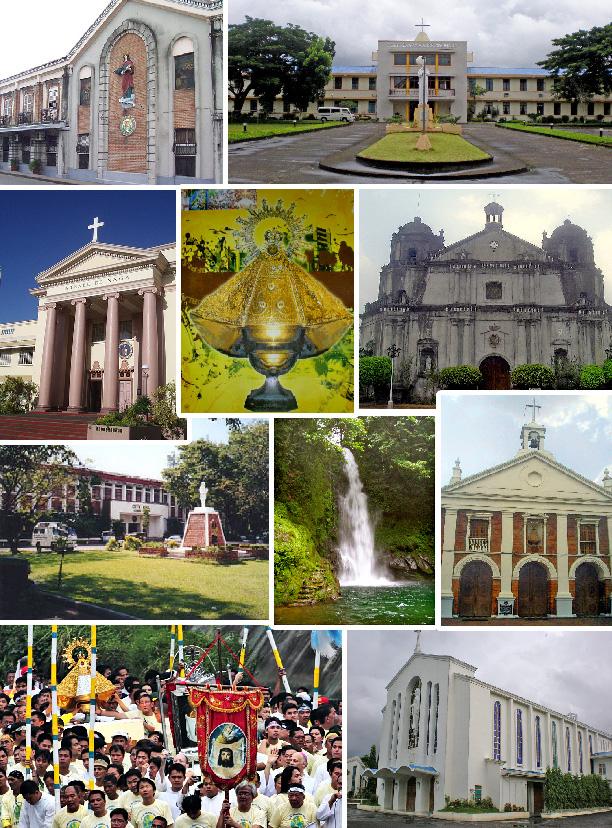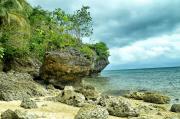
Naga City Montage
The City of Naga is an independent component city in the Bicol Region of the Philippines. The city was established in 1575 on order of Spanish Governor-General Francisco de Sande. The city, then named Ciudad de Nueva Caceres (New Caceres City), earned its status as the third Spanish royal city in the Philippine islands, after Cebu and Manila.
Naga is nicknamed as the "Heart of Bicol" for its geographical location near the center of the Bicol Peninsula. It is the second largest city in the Bicol Region (Region V) in terms of population and the religious, financial, educational, trade, and commercial center of the Bicol Region. Residents of the city are called Nagueños.
Naga City is at the core of Metro Naga, an official designation given the city and 14 municipalities in the area administered by the Metro Naga Development Council. MNDC covers the entire 2nd district of the province of Camarines Sur, and part of its 1st, 3rd and 4th districts.
Naga City is the Bicol Region's top tourist destinations not only because of Peñafrancia Festival, it is also a convenient disembarkation point and base for other tourist destinations in the southern Bicol Region like the Caramoan, Camarines Sur, the upscale resort of Misibis, butanding (whale shark) watching during their migration in Donsol, the white sand beaches of Sorsogon and surfing beaches of Catanduanes provinces.
Physical Features
The city of Naga is located within the province of Camarines Sur in the southeastern tip of Luzon at the near the center of the Bicol Region, surrounded on all sides by rich agricultural, forest and fishing areas. It covers a land area of 8,448 hectares (20,880 acres) and is located around the serpentine and historic Naga River, at the confluence of the Naga and Bikol Rivers. Thus, it has always been an ideal place for trade and as a center for schools, church and government offices. Included in its territory is Mount Isarog, a declared protected area in Region V known as Mount Isarog Natural Park.
Naga City is located 377 kilometers (234 mi) Southeast of Manila, the nation's capital, and about 380 kilometers (240 mi) northeast of Cebu City, the second largest city in the country.
Places of Interest
Churches and monasteries
- The Naga Metropolitan Cathedral is the oldest cathedral established in the whole southern Luzon. It was built in 1573, and was inaugurated in 1575. It is also the cathedral of the Archdiocese of Caceres
- Our Lady of Penafrancia Shrine is the original home of Our Lady of Peñafrancia for two centuries. It was established in 1750.
- Peñafrancia Basilica Minore, established in 1985, it is the new home of Our Lady of Peñafrancia where the Traslacion starts when her image is led into procession around the city streets then brought to the cathedral.
- San Francisco Church, established in 1578, it is the first church in the region built by the Franciscan Friars. The surrender of the Spanish forces to the Bikol revolutionaries Elias Angeles and Felix Plazo took place here on September 18, 1896. The church was reduced to rubble by the heavy bombing of Naga in World War II, and the church remained in ruins until the present new edifice was constructed.
- St. Jude Churches in del Rosario
- Carmelite Church and Monastery
- Holy Rosary Major Seminary and Church
- Immaculate Conception Church
- Caritas Mariae Church in Pacol
- Christ the King Church, Ateneo de Naga Univ.
- Holy Cross Parish Church in Barangay Tabuco.
Natural Attractions
- Mount Isarog is a dormant volcano and a national park open for trekking and mountain biking
- Malabsay Falls
- Mt. Isarog Hot Springs and resorts
- Casa Ofelia Resort in Carolina
- Stonehouse Gardens Resort
Historical Landmarks
Nine sites and landmarks in the city with historical value.
- Calle Via Gainza, now Peñafrancia Avenue, was first known as Via Gainza in honor of Bishop Francisco Gainza, O.P. (1863–1879), the 25th and considered as the greatest Spanish bishop of the See of Caceres.
- Calle Real, now Elias Angeles Street, was one of the earliest streets in Spanish Nueva Caceres laid out at the close of the 16th century. The street figured as a historic backdrop to the events of September 1898, which established the Filipino revolutionary government headed by Elias Angeles.
- Calle de Legaspi at the western portion of Panganiban Drive, was established in 1839 after the Naga River was straightened as a shortcut from Calle Real to the new western bank of the river.
- Casa Real site on General Luna Street. The Casa Real, the government building of Nueva Caceres, was established at this location in 1588
- Casa Tribunal site on Elias Angeles Street was the original site of the Casa Tribunal or “common house” which provided free rooms to travelers until 1839.
- Casino Español site at the corner Elias Angeles and Arana Street, was the location of Casino Español, a spacious building of piedra china and wood that served as the social and recreational center of the male Spanish population of Nueva Caceres and neighboring towns.
- House of Tomas Prieto site at the corner Panganiban Drive and Peñafrancia Avenue was the site of the Bicolano martyr, Tomas Prieto, who was executed on January 4, 1897 at the Bagumbayan Field in Manila together with ten others, collectively known as the "Bicol Martyrs."
- The Naga City Police Station on Barlin Street was the site of the Cuartel General of the Guardia Civil in Camarines that was constructed in 1870, but was razed by fire caused by faulty electrical wiring.
- Puente de Naga, now Lt. Delfin Rosales Bridge, the massively designed concrete bridge was constructed in 1847 and was known as Puente de Naga, and until the 1920s when the bridge was renamed in honor of Bicolano Jose Maria Panganiban. It was renamed again in 1989, to honor Lt. Delfin C. Rosales in World War II, during the battle for Naga in April 1945.
- PLAZA QUINCE MARTIRES It is the site where a monument that honors the 15 Martyrs of Bicol was built. It was on January 4, 1897 or barely 5 days after the National Hero –Dr. Jose P. Rizal – was executed when the 11 prisoners from Bicol were also executed on the same field in Bagumabayan (now Luneta). The four others had either died in prison due to severe torture or while in exile in the island of Fernando Poo, off the coast of Africa. The monument, which was located in the city’s Central Business District 1, was built on November 29, 1926.
- PLAZA RIZAL This monument-cum-park ideally located at downtown Naga was built in honor of the national hero, Dr. Jose Rizal. This is known locally as the center for public debates and discussions, family picnic gatherings and public recreation and relaxation spot.
Museums
- The Holy Rosary Minor Seminary Museum showcases Bicol's ancient relics and artifacts like burial jars, ancient china wares, rare stones and ritual objects. The museum also features local church history where old Church vestiges and sacred objects are displayed.
- The Penafrañcia Museum contains sacred vestiges related to Marian devotion to Our Lady of Peñafrancia.
- The University of Nueva Caceres Museum is one of the oldest museums outside Manila and recognized by the International Association of Museums. It houses historical artifacts of ancient Bikol, its people and culture.
- Bicol Science and Technology Centrum is a science museum established in 1993 in partnership with the Department of Science and Technology to cater to the science and technology education for young, professionals, teachers and enthusiasts alike. It features an exhibit of interactive gadgets, a skywatch gallery, a sci-cubby hole for the kids, an audio-visual room and a cybercafe for internet users.
Sports and Recreation
- Metro Naga Sports Complex in Barangay Pacol has Olympic-sized swimming pools, tennis courts and a track oval.
- Naga City Coliseum (Big Dome of the South)
Nightlife
The nightlife in Naga City is considered to be the most vibrant in Bicol. It is concentrated along Magsaysay Avenue where restaurants, bars and music lounges re lined up catering to tourist and locals alike.
Festival
- The Peñafrancia Festival
The city celebrates the Feast of Nuestra Señora de Peñafrancia, Our Lady of Peñafrancia, the Patroness of the Bicol Region starts the second Friday of September each year. The start of the 10-day feast, one of the largest Marian devotions in the country, is signalled by a procession (called Traslacion) which transfers the centuries-old image of the Blessed Virgin Mary from its shrine at the Peñafrancia Basilica Minore to the 400-year old Naga Metropolitan Cathedral. Coinciding with nine days of novena prayer at the cathedral, the city celebrates with parades, pageants, street parties, singing contests, exhibits, concerts, and other activities. Finally, on the third Saturday of September, the image is returned shoulder-borne by so-called voyadores to the Basilica Minore de Nuestra Señora de Peñafrancia via the historic Naga River.
List of Accommodations
There is always a place to stay for everyone in Naga City no matter the purpose of the visit or budget. Naga offers a variety of accommodations such as hotels, hostels, inns, and apartelles that showcase the Nagueños warmth and hospitality.
- The Avenue Plaza Hotel - Magsaysay Avenue, Naga City
- Star View Plaza Hotel - Elias Angeles St., Naga City
- Villa Caceres Hotel - Magsaysay Avenue, Naga City
- Naga Regent Hotel - Elias Angeles St., Naga City
- Naga Manor Hotel
- Location: Balatas Road, Naga City
- New Crown Hotel - 39 P. Burgos Street, Naga City
- Naga City Youth Hostel - 14 Taal Avenue, Naga City
- Travel Suite - 45 Almeda Road, San Felipe, Naga City
- White Dahlia Apartelle - Mayon Ave. cor. Caimito St., Naga City
- Happy Side Apartment Homes - Narra St., Magsaysay Ave., Naga City
- Sixteen Lodging House - Roxas Ave., Triangulo, Naga City
- 24 Hours Lodging House - PNR Road, Triangulo, Naga City4736435
- Peñafrancia Resort - Brgy. Carolina, Naga City
Getting There
Naga City is easily accessible by air and land. The city is served by the Naga (WNP) Airport which is located in the barangay of San Jose in the nearby town of Pili. Flights from Ninoy Aquino International Airport to Naga takes approximately 35–40 minutes with services provided by Cebu Pacific and Air Philippines three and two times a day, respectively. By land, Naga is a 7- to 8-hour ride from Manila via Quirino & Andaya Highways or 10 hours via the Maharlika Highway. It is approximately 22 hours from Cebu City with ferry transfers in Sorsogon, the southernmost province of the Bicol peninsula. Buses ply to Sorsogon and Tacloban. Daily rail services to and from Manila used to be provided by Philippine National Railways.
Getting Around
Within the city, the dominant mode of transportation is the tricycles and jeepney, the latter a 16- to 22-seater stretched version of the American jeep. The jeepney, dubbed as “The King of the Road of the Philippines”, is abundant all over the city. It is available for long distance travel and around the city on their designated routes.
Other means of transportations can also be found at very affordable prices. The ‘padyak’ or ‘pedicab’ is a bicycle with a sidecar. It is good for short-distance travels when you are not in a hurry. It is light and moves around the quaint village streets of the city. Naga still has a number of horse-drawn carriages called ‘calesa’ along Abella Street.
The ‘tricyle’ is a motorcycle with a sidecar for short and long distance travel. They are color-coded according to their routes but, can go around other places outside their regular fare for special trips.
Taxis are available. They are generally stationed in key commercial and tourist hot spots. They are all airconditioned with friendly drivers. T hey can be contacted through their agents or the driver’s personal mobile numbers.










